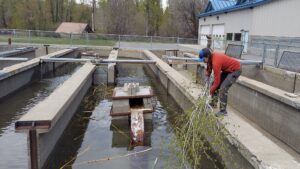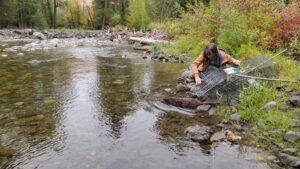Methow Okanogan Beaver Project provides live-trapping and relocation services in situations of irreconcilable conflict with beavers. We relocate these beavers from private lands to our restoration sites where they become important partners in watershed restoration, helping us slow and spread water, restore complex stream dynamics, reconect streams to their floodplains, and increase wildfire and drought resilience.
By slowing and spreading the flow of water, beavers provide innumerable ecological benefits like improved biodiversity, higher water tables and healthier plants, flood control, drought mitigation, and wildfire resilience. These positive effects make beavers an asset even in developed landscapes. However, sometimes conflict can occur if beavers chew down desired trees, or build dams that threaten to flood roads, structures, or agricultural fields.
At MOBP we have many strategies to help landowners successfully coexist with beavers, such as tree wrapping and flow device installation. Relocating beavers isn't our first-choice response to beaver-human conflicts because it is often only a temporary solution for the landowner. When beavers have chosen an area to live in, they make improvements to the system. When a previously occupied site is vacated by removal of beavers, other beavers quickly find the improved habitat and happily utilize it, putting landowners right back where they started.
We have found that most landowners can agree that they would not mind living with beavers if their activity wasn’t damaging or threatening their property. Let us help you find the right beaver management solutions for your property and restoration site challenges.
Having beaver challenges?
Methow Okanogan Beaver Project provides site consultations, free of charge. On a case-by-case basis, we analyze what coexistence methods may work best for your situation and offer beaver relocation services where unavoidable.
CONTACT US to schedule a consultation or to learn more.
Beaver solutions hotline:
(509) 298-2770
So why relocate beavers?
As much as we'd love it if every beaver/human conflict could be solved with coexistence strategies, for a variety of reasons, coexistence isn't always possible. In some situations, coexisting isn't an option and in others, landowners have tried every coexistence option and are still having beaver-related conflict. That's where relocation comes in!
By strategically relocating beavers from situations of irreconcilable human conflict to targeted restoration areas, MOBP prioritizes our committed partnership with this keystone species. Through relocation, beavers get a new home where they're welcomed, and in return, our communities benefit from expert ecosystem engineers who improve and expand habitat restoration... a perfect interspecies partnership!
How does relocation work?

Step 1: Live-Trapping
Once a decision has been made that beavers must be relocated, trained beaver-relocation professionals, both MOBP staff and state-certified wildlife control operators, set humane traps to capture the targeted beavers.
Step 2: Holding
Once beavers have been live-trapped, we bring them to our temporary holding facilities at the USFWS Winthrop National Fish Hatchery where they wait for other family members to join them before being transported to their new home. At the hatchery, beavers have access to plenty of fresh water to swim in and a small structure to simulate a lodge or bank den. Trained volunteers supply them with their favorite foods- aspen, willow, and cottonwood branches. Beavers are weighed and measured, and given an identification and tracking chip called a PIT tag for future monitoring.


Step 3: Relocation
MOBP carefully selects relocation sites without an established population of beavers, plenty of deep water for beavers to escape predators, and enough food for them to thrive. We relocate beavers onto public and private lands, but we target our stream restoration sites because they most often meet beavers basic needs better than other locations. Contact us if you are interested in exploring the opportunity to have beavers relocated to your property.
Beavers are transported from the hatchery to their new home, where we hope they stick around to help make our restoration sites wetter, greener, more biodiverse, and more wildfire- and climate-resilient.